Related Research Articles
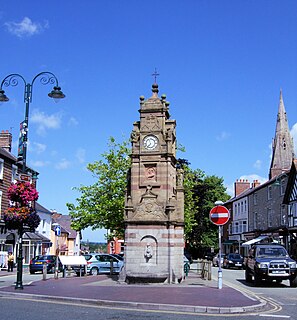
Ruthin is a market town and community in Denbighshire, Wales, in the south of the Vale of Clwyd. It is Denbighshire's county town. The town, castle and St Peter's Square lie on a hill, skirted by villages such as Pwllglas and Rhewl. The name comes from the Welsh rhudd (red) and din (fort), after the colour of sandstone bedrock, from which the castle was built in 1277–1284. The Old Mill, Ruthin, is nearby. Maen Huail, a registered ancient monument attributed to the brother of Gildas and King Arthur, stands in St Peter's Square.
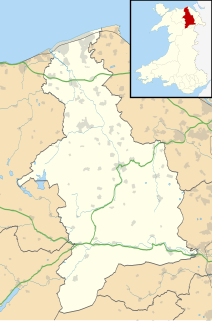
Denbighshire is a county in the north-east of Wales. Its borders differ from the historic county of the same name. This part of Wales contains the country's oldest known evidence of habitation – Pontnewydd (Bontnewydd-Llanelwy) Palaeolithic site has Neanderthal remains of some 225,000 years ago. Castles include Denbigh, Rhuddlan, Ruthin, Castell Dinas Bran and Bodelwyddan. St Asaph, one of Britain's smallest cities, has one of its smallest Anglican cathedrals.
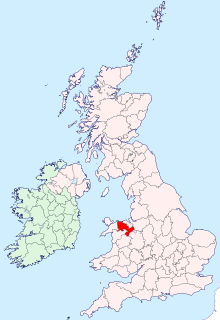
Historic Denbighshire is one of thirteen traditional counties in Wales, a vice-county and a former administrative county, which covers an area in north east Wales. It is a maritime county, bounded to the north by the Irish Sea, to the east by Flintshire, Cheshire and Shropshire, to the south by Montgomeryshire and Merionethshire, and to the west by Caernarfonshire.

Denbigh is a market town and a community in Denbighshire, Wales. Formerly, the county town, the Welsh name translates to "Little Fortress"; a reference to its historic castle. Denbigh lies near the Clwydian Hills.

The Diocese of Saint Asaph is a diocese of the Church in Wales in north-east Wales, named after Saint Asaph, its second bishop.

The Vale of Clwyd is a constituency of the House of Commons of the UK Parliament created in 1997 and represented since 2019 by James Davies of the Conservative Party. As with all extant seats its electorate elect one Member of Parliament (MP) by the first past the post system at least every five years.

Llandyrnog is a large village and community in Denbighshire, Wales lying in the valley of the River Clwyd, about 3 miles (4.8 km) from Denbigh and 5 miles (8.0 km) from Ruthin. The village has good road links to Denbigh and the main A541 road at Bodfari, and is served by buses number 76 and 53. The village contains the Church of St. Tyrnog's is a Grade II* listed building, and has a notable creamery on the outskirts and former hospital. The community includes the settlements of Waen, Ffordd-las and Llangwyfan.
John Roberts of Llwyn Ynn, Llanfair Dyffryn Clwyd, Denbighshire was a Welsh politician who sat in the House of Commons between 1710 and 1722.
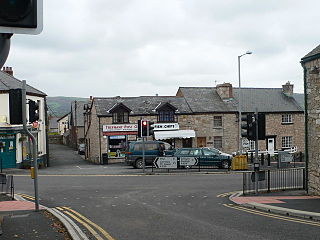
Trefnant is a village and community in Denbighshire, Wales. It is located on the A525 road in the Vale of Clwyd, about halfway between St Asaph (Llanelwy) to the north and Denbigh to the south. At the 2001 Census, the community had a population of 1,409, increasing to 1,581 at the 2011 Census.

Llanfair Dyffryn Clwyd is a village and community in Denbighshire, Wales, situated in the Vale of Clwyd about one mile south of the town of Ruthin. By the 2001 census, it had 1048 residents and 50.6% of them could speak Welsh. The figures for the 2011 census were: population 1,053:Welsh speakers 46.9%. The age group with the highest percentage of Welsh speakers was the 15-year-olds where every one could speak it. The villages of Pentrecelyn and Graig Fechan are located in the community.
The office of High Sheriff of Clwyd was established in 1974 as part of the creation of the county of Clwyd in Wales following the Local Government Act 1972, and effectively replaced the shrievalties of the amalgamated counties of Flintshire and Denbighshire.

In the United Kingdom, the term listed building refers to a building or other structure officially designated as being of special architectural, historical, or cultural significance; Grade I structures are those considered to be "buildings of exceptional interest". Listing was begun by a provision in the Town and Country Planning Act 1947. Once listed, strict limitations are imposed on the modifications allowed to a building's structure or fittings. In Wales, the authority for listing under the Planning Act 1990 rests with Cadw.
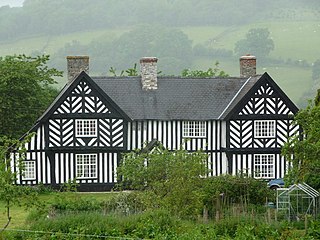
Penarth is a timber-framed house set back from the A483 road near to Newtown, Wales, close to the banks of the river Severn. It is within the parish of Llanllwchaiarn, within the historic county of Montgomeryshire, which now forms part of Powys. It is amongst the best examples of the ‘‘Severn Valley’’ timber-framed houses. The Penarth vinyard stands within the grounds of the house.
Townshend Mainwaring was a British Conservative Party politician.

Joseph Ablett was a philanthropist and High Sheriff of Denbighshire, a county in Wales, in 1809.

Gallfaenan Hall, also known as Alltvaynan, is a Grade II listed building near to Trefnant and Henllan in Denbighshire, Wales.
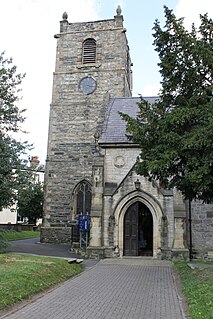
St Collen's Church is a parish church in the town of Llangollen, Denbighshire, Wales. The first church on the site was founded by Collen in the 6th century. Nothing of this building remains. A new church was built in the 13th century, in the Early English Gothic style. This was developed in the succeeding centuries, and then almost completely rebuilt in the 19th century. The architect of the Victorian reconstruction was Samuel Pountney Smith, who retained little of the earlier church, with the exception of the tower. The churchyard contains the grave of the Ladies of Llangollen, Eleanor Charlotte Butler and Sarah Ponsonby, and their servant Mary Carryl, who lived at the nearby Plas Newydd. In November 2021 the first blessing of a gay partnership in a Church in Wales church was held at St Collen's. The church is an active parish church in the Diocese of St Asaph. It is designated by Cadw as a Grade I listed building.
References
- ↑ Brodie, Antonia, ed. (2001). Directory of British Architects, 1834-1914: Vol. 2 (L-Z). A. & C. Black. p. 1004. ISBN 978-0-82645-514-7.
- ↑ Lowe, Jeremy B. (1985). Welsh Country Workers Housing 1775-1875. National Museum Wales. p. 29. ISBN 978-0-72000-298-0.
- ↑ "Galltfaenan Hall". British Listed Buildings. Retrieved 2 January 2019.
- ↑ "Denbigh Railway Station, Denbigh (54009)". Coflein. RCAHMW . Retrieved 29 September 2021.
- ↑ "Plans of Bettws yn Rhos National School". Denbighshire Archives Service. Retrieved 2 January 2019.
- ↑ "Llanfair Dyffryn Clwyd National School, records of". Denbighshire Archives Service. Retrieved 2 January 2019.
- ↑ "North Wales Mental Hospital Chapel, Pont Ystrad Road, Denbigh (11623)". Coflein. RCAHMW. Retrieved 29 September 2021.
- ↑ "Parish Church of St James". British Listed Buildings. Retrieved 2 January 2019.
- ↑ "Pontblyddyn Church History". Leeswood Community Online. Retrieved 2 January 2019.
- ↑ "Town Hall". British Listed Buildings. Retrieved 2 January 2019.
- ↑ Llangollen: Understanding Urban Character (PDF). CADW. 2016. p. 36. ISBN 978-1-85760-377-4.
- ↑ "The Church House (Old Grammar School)". British Listed Buildings. Retrieved 2 January 2019.
- ↑ "Church of St Winifred". British Listed Buildings. Retrieved 2 January 2019.
- ↑ "St Mary's Church". British Listed Buildings. Retrieved 2 January 2019.
- ↑ "Model Farmbuildings Approximately 110 Metres South West of Trewern". British Listed Buildings. Retrieved 2 January 2019.
- ↑ "Frongoch Board/Council School, records of". Denbighshire Archives Service. Retrieved 2 January 2019.
- ↑ "Parish Church of St Tudclud". British Listed Buildings. Retrieved 2 January 2019.